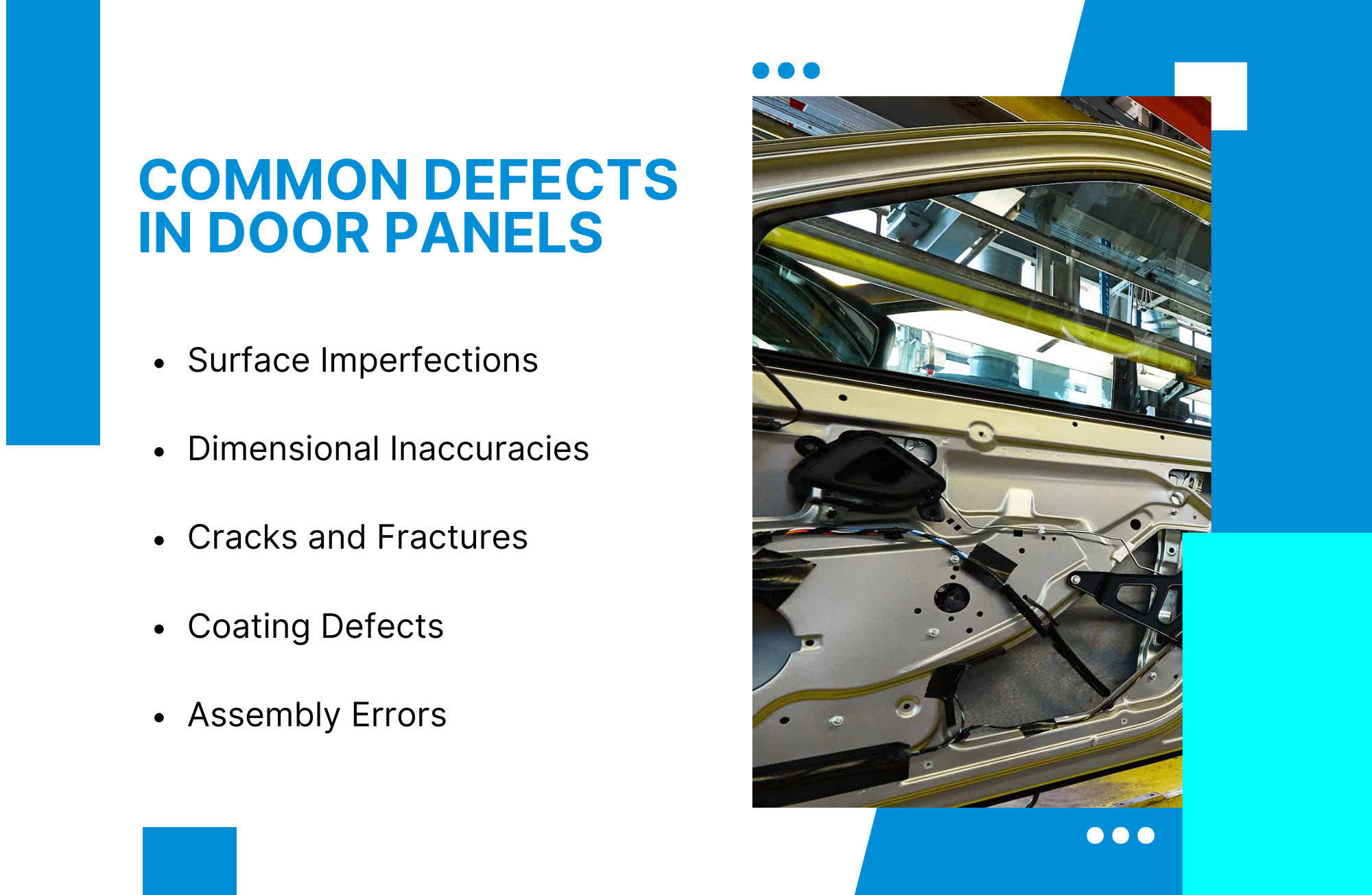How to automate Door Panel Inspection with Machine Vision AI
Published on: Feb 04, 2025

Written by: Content team, Intelgic
How to automate Door Panel Inspection with Machine Vision AI
In today’s manufacturing environment, the demand for precision, efficiency, and consistency has reached unprecedented levels. To meet these challenges, industries are increasingly adopting advanced technologies designed to streamline processes, minimize human error, and improve product quality. A key innovation driving this transformation is the integration of machine vision cameras and artificial intelligence (AI) into automated inspection systems. This article explores how these technologies work together to streamline the inspection process, the workflow involved, the benefits of automation, and how Intelgic’s expertise can help businesses implement these solutions effectively.

Common Defects in Door Panels
Some of the most common defects include:
- Surface Imperfections: Scratches, dents, and uneven textures can compromise the aesthetic appeal and functionality of door panels.
- Dimensional Inaccuracies: Variations in size, shape, or alignment can affect the fit and finish of the door panel.
- Cracks and Fractures: Structural defects, such as cracks or fractures, can weaken the door panel and pose safety risks.
- Coating Defects: Irregularities in paint or coating application, such as bubbles, streaks, or uneven thickness, can lead to corrosion or premature wear.
- Assembly Errors: Misaligned components, missing fasteners, or improper sealing can result in functional failures.

Automated Inspection with Machine vision AI
Automating door panel inspection involves the integration of advanced technologies meticulously designed to ensure precise defect detection, enhance operational efficiency, and enable seamless scalability. These technologies— advanced imaging solutions, lighting systems, and AI software—work in harmony to revolutionize the inspection process, delivering unparalleled accuracy and consistency.
Advanced Imaging Solutions
Advanced imaging solutions are pivotal in elevating the precision and efficiency of automated door panel inspection. These cutting-edge technologies provide deeper insights into the surface and structure of door panels, allowing for the detection of defects that are invisible to traditional methods ensuring consistent quality control, accuracy, and scalability in manufacturing.
- Area Scan Cameras: Area scan cameras capture high-resolution 2D images, providing detailed surface analysis of the door panels. This technology facilitates precise detection of visible defects such as scratches, dents, and misalignments.
- 3D Imaging Cameras: For more intricate inspections, 3D imaging cameras offer a three-dimensional view of the door panel, enabling the detection of defects related to geometry or surface structure that are invisible in 2D imaging. This technology is ideal for identifying warped or misaligned panels.
- Multispectral Cameras: These sophisticated cameras capture images across various wavelengths of light, expanding the capability to detect defects like surface texture irregularities, which are undetectable by the human eye or standard imaging systems. This technology enhances the inspection process by identifying subtle flaws that might otherwise go unnoticed.
Lighting Systems
Proper lighting is crucial to achieving optimal performance from machine vision cameras. Lighting systems help eliminate shadows and reflections that could interfere with the accuracy of image analysis. Various types of lighting systems are used to ensure consistent illumination:
- Structured Lighting: This system projects patterns onto the door panel surface. The patterns are used to highlight surface defects by creating contrast between the normal surface and areas with flaws.
- LED Arrays: LED arrays provide uniform, consistent lighting across the entire surface of the door panel. This ensures that images are clear and free of shadows or glare.
- Diffuse Lighting: This type of lighting evenly distributes light across the surface of the panel, reducing the potential for reflections and ensuring that the panel is illuminated uniformly for consistent image quality.
AI Software
Intelgic’s Live Vision Software plays an essential role in the automation of door panel inspection by leveraging advanced machine learning algorithms and analyzing images captured by machine vision cameras to detect defects in real time. The system is capable of self-improvement, learning from increasing volumes of data, and enhancing its accuracy in identifying even the most subtle imperfections.This software can detect a broad spectrum of defects, including surface irregularities, color inconsistencies, and geometric misalignments and can also facilitates immediate decision-making by flagging defective panels without delay, enabling rapid responses within the manufacturing process. As the AI system continues to process data, it progressively refines its detection capabilities, enhancing both the precision and speed of its performance over time.
.Automated Inspection Workflow
The automated door panel inspection process typically follows a structured workflow involving machine vision cameras, AI software, and lighting systems. Below is an overview of the steps involved in this workflow:
- Panel Movement and Positioning: The door panels are placed on a conveyor belt or automated transport system. The panels are aligned and moved through the inspection area where machine vision cameras and lighting systems are positioned.
- Image Capture: As the panels pass through the inspection station, machine vision cameras capture high-resolution images of the surface. The cameras work in tandem with the lighting system to ensure uniform illumination, minimizing shadows and glare that could hinder defect detection.
- Image Processing with AI: Once the images are captured, AI-powered software analyzes them to detect any defects. Using machine learning, the AI software compares the images against predefined quality criteria to identify any inconsistencies or flaws in the panel's surface, texture, or geometry.
- Defect Identification and Classification: The AI software classifies the identified defects according to their type and severity. For example, surface scratches may be classified as minor defects, while dents or misalignments may be classified as more severe issues requiring corrective action.
- Decision-Making and Action: Based on the severity of the defects detected, the AI software can trigger various actions. Panels with minor defects may be flagged for further inspection, while those with more severe defects may be automatically removed from the production line for repair or rejection.
- Reporting and Feedback: The system generates real-time reports on the inspection results, allowing operators to monitor the quality of the panels. These reports may include data on the types and frequency of defects, enabling manufacturers to adjust the production process if needed to reduce defects in future panels.
Benefits of Automating Door Panel Inspection using AI
Automating door panel inspection with machine vision cameras and AI offers numerous advantages over traditional manual inspection methods:
- Increased Accuracy: Machine vision cameras, combined with AI software, can detect defects with greater accuracy and precision than human inspectors. This ensures that no defective panels slip through the inspection process.
- Speed and Efficiency: Automated inspection systems can process large volumes of panels much faster than manual inspection, significantly increasing throughput and reducing inspection time per panel.
- Consistency and Reliability: Automation ensures that the inspection process is consistent, eliminating the variability that can occur with human inspectors. This leads to more reliable quality control across all panels.
- Cost Savings: By reducing the need for manual labor and minimizing the chances of defective products reaching the market, manufacturers can lower costs related to recalls, repairs, and rework.
- Scalability: Automated systems can easily scale to accommodate higher production volumes without sacrificing inspection quality or efficiency.
- Data-Driven Insights: AI-powered systems can collect and analyze data over time, providing valuable insights into the manufacturing process and allowing for continuous improvement.
Intelgic's Expertise in Automated Quality Control
Intelgic is a pioneer in providing state-of-the-art solutions for automated quality control in manufacturing. Intelgic excels in the seamless integration of advanced technologies, ensuring highly accurate and efficient inspection processes.Here’s how Intelgic leads the way in this field:
Technology Integration: Renowned for its expertise in seamlessly integrating machine vision cameras, AI software, and advanced lighting systems for precise door panel inspection.
High-Performance Systems: Utilizes cutting-edge machine vision cameras and AI-driven software to deliver unparalleled reliability and accuracy in defect detection.
Custom Solutions: Specializes in crafting bespoke solutions tailored to the unique needs of each manufacturer, ensuring peak performance and adaptability.
Workflow Design: Demonstrates exceptional proficiency in designing and optimizing inspection workflows, calibrating camera settings, and fine-tuning lighting systems for maximum operational efficiency.
Automating door panel inspection using machine vision cameras and AI is transforming the manufacturing process, offering significant benefits in terms of accuracy, speed, consistency, and cost savings. By integrating advanced imaging solutions, appropriate lighting systems, and AI-powered software, manufacturers can ensure that every panel meets strict quality standards before it reaches the market.

